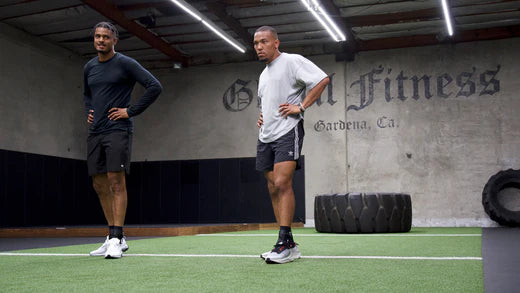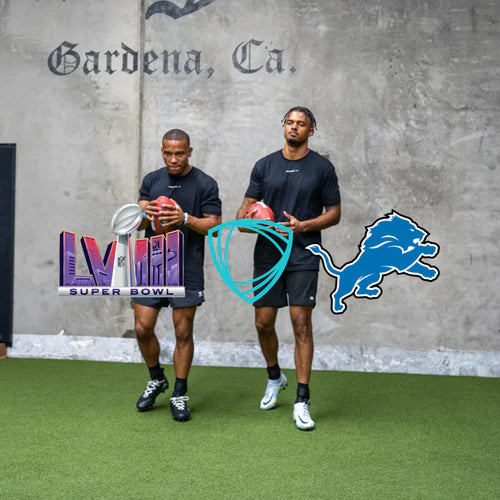Have you twisted your ankle while doing sports or in your everyday life? Now it's time for the right treatment. For minor injuries, the renowned sports physician Dr. Lukas recommends the RICE method, which you can use to treat a twisted ankle yourself. For more serious injuries, a visit to the doctor may be necessary. This article will help you make the right decision.
Go directly to the RICE method >
Contents
-
Twisted ankle: what to do?
-
Mild injury: sprained or overstretched ligaments
-
Moderate injury: partial tear of the ligaments
-
Severe injury: complete tear of the ligaments
- Twisted your ankle? The RICE method will help you heal
-
Protect your ankle from twisting during sports
- Further information: Typical symptoms of a twisted ankle
Twisted your ankle? What should you do?
To help you make the right decision quickly, you should take a close look at your foot and observe your symptoms. There are different degrees of severity.
Mild injury: sprained or overstretched ligaments
The ligaments that stabilize your ankle have been slightly overstretched by the twisting, but have not torn.
Symptoms:
- mild pain in the ankle, especially when moving
- minimal or no swelling
- no visible bruising
- the foot can be put under stable load with mild discomfort
Treatment:
If you have stretched a ligament, you don't need to see a doctor right away. You can also apply the RICE scheme yourself. However, if your symptoms persist or worsen after the first 24-48 hours after the injury, see a doctor.

Moderate injury: partial tear of the ligaments
Some of your ligaments were damaged when you twisted your ankle, but the other part is still intact. Your ankle is noticeably unstable.
Symptoms
- Moderate to severe pain in the ankle
- Significant swelling around the ankle, often within a few hours
- A bruise after 1-2 days
- Mobility and stress are limited
- You feel instability and wobbling in your ankle
Treatment
If you experience any of the above symptoms in your ankle or foot, you should definitely see a doctor. They will diagnose the exact injury, assess the swelling and rule out any possible accompanying injuries. If you have a partial tear, you may need a splint, medication and/or physiotherapy to do exercises to improve mobility, coordination and muscle strength.
Severe injury: complete ligament rupture
A complete ligament rupture occurs when one or more ligaments in the ankle are completely torn. Your ankle will suffer from significant instability and you may have accompanying injuries.
Symptoms
- The pain occurred suddenly and intensely, often accompanied by a cracking sound when you twisted your ankle.
- Severe swelling that increases rapidly
- usually a large bruise that spreads in the days following the injury
- significant instability, your foot can hardly bear weight
- range of motion is limited. Your foot can no longer be fully bent or stretched
Treatment
If you experience these symptoms when and after twisting your ankle, a medical examination is absolutely necessary. In most cases, you will be given a splint or a cast. In severe cases, surgical stabilization is also necessary.
Twisted your ankle – the RICE method aids recovery

Orthopedist and sports medicine specialist Dr. Lukas has been treating professional handball, basketball, and soccer teams for over 20 years. Treating twisted ankles and ankle injuries is part of his standard repertoire. He explains: “If your foot has twisted, your ankle is swollen and perhaps even discolored, you should apply the so-called RICE method immediately after twisting your ankle.” The name of this rule also outlines the individual measures. Dr. Lukas has exactly four tips on how to treat a twisted ankle immediately after the injury occurs. These are his expert tips:
1. R for Rest
If you twist your ankle outwards, you should definitely stop training or playing. This also applies if you twist your ankle but do not feel pain immediately afterwards. It is important to get adequate diagnosis as quickly as possible. This will prevent the injury from getting worse.
2. I for Ice
If you twist your ankle, cool it! It doesn't have to be ice. A cold spray, for example, also helps to minimize swelling or bruising. Sponges soaked in ice water are also ideal for cooling. This is known as “hot ice”. If you use ice or cool packs, make sure that they do not come into direct contact with the skin. This has a negative effect because after the cooling is removed, blood is sent to the area to equalize the temperature.
3. C for Compression
At the same time, a light pressure bandage should be applied. This immobilizes the joint and reduces the swelling caused by the hematoma. You should also bandage the twisted foot later.
4. E for Elevation
A sprained foot must always be raised above heart level to effectively combat swelling. This applies both immediately after the injury and during the later recovery process.
Protect your ankle joints from spraining during sports
To minimize the risk of sprains and lateral joint injuries during sports, we have developed The BetterGuard. Wear the intelligent ankle support during your game and experience how it supports you during critical movements. If your foot is at risk of twisting, the mini-piston in the support reacts immediately and stabilizes your outer ligament before a painful accident occurs.
Further information: Typical symptoms of a twisted ankle
As a rule, swelling develops immediately, accompanied by sometimes severe pain. If the ankle is twisted, there is usually also a bruise. You can quickly recognize this by the typical blue coloration around the ankle. This coloration is caused by bleeding into the tissue.
However, it is not always necessarily the case that one or more torn ligaments are involved. Strains and sprains can also cause severe pain if you have twisted your ankle. Only an exact diagnosis by a specialist can reveal the type and severity of the injury. In any case, you should immediately take first aid measures if your foot is twisted, swollen and possibly even discolored.
Twisted ankle: these are the consequences you need to expect
Twisting your ankle often results in swelling and pain. However, these are just the first symptoms. Twisting your ankle can also cause more serious injuries. Doctors also refer to these types of injuries as supination trauma. This is when the foot twists inwards while the body weight is shifted outwards. The outer ligaments (the ligaments on the outside of the ankle) are stretched or even torn.
In most cases, at least one of the three ligaments that are in direct contact with the ankle is injured. The severity and duration of such an injury depends primarily on how quickly and forcefully the foot twists. An ankle injury is particularly likely to occur in sports that involve frequent jumping and quick changes of direction.
This is particularly the case in football, handball and other ball sports, but is also a recurring sequence of movements in trail running, gymnastics or tennis. Ex-handball pro Kevin Struck (Füchse Berlin, VfL Potsdam), for example, experienced this. His ordeal lasted a total of six months after he twisted his ankle at the Club World Cup in Doha in 2018.
Questions that athletes often ask themselves when they twist their foot
If you twist your ankle and can't put a name to the symptoms, it can be unsettling. Here you will find answers to questions that athletes often ask themselves.
What could it be: twisted your ankle, no swelling but pain?
If you twist your ankle but there is no swelling, it may be a slight strain or sprain of the ligaments. The stabilizing ligaments of the ankle joint were strained but not torn. Often, pain occurs during movement or exertion, but this will subside after a while. If the pain persists for a longer period of time or becomes more severe, a medical examination is advisable.
When should you see a doctor after twisting your ankle?
You should see a doctor if:
- the pain is severe and does not subside
- there is significant swelling or bruising
- the foot is unstable or can hardly bear weight
- you feel that your foot is twisting or twisting
- you have heard a cracking sound when twisting
If you are unsure or have persistent symptoms, it is always a good idea to seek medical advice.
How do I recognize a torn ligament?
A torn ligament often manifests itself through the following symptoms:
- sudden, severe pain, usually with a cracking sound when you twist your ankle
- rapidly increasing swelling
- bruising that spreads after one to two days
- Noticeable instability: your foot feels unstable
- Limited mobility: you can hardly bend or stretch your foot
A doctor can make a clear diagnosis through clinical tests and, if necessary, imaging (e.g. MRI).
When should you tape an ankle sprain?
Taping can be useful if:
- you have a minor injury (such as a sprained ligament) and want to start exercising again
- you have already had an ankle injury and are looking for additional protection
- you want to stabilize your ankle preventively to avoid twisting it again
If you have a torn ligament or severe symptoms, taping alone is not enough – a splint or targeted therapy is also necessary. Alternatively, The BetterGuard offers a modern solution: an intelligent ankle brace that adapts flexibly and only stabilizes you when it's needed.








